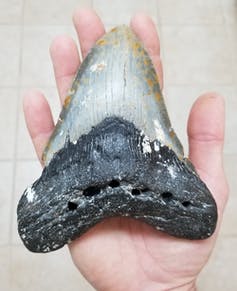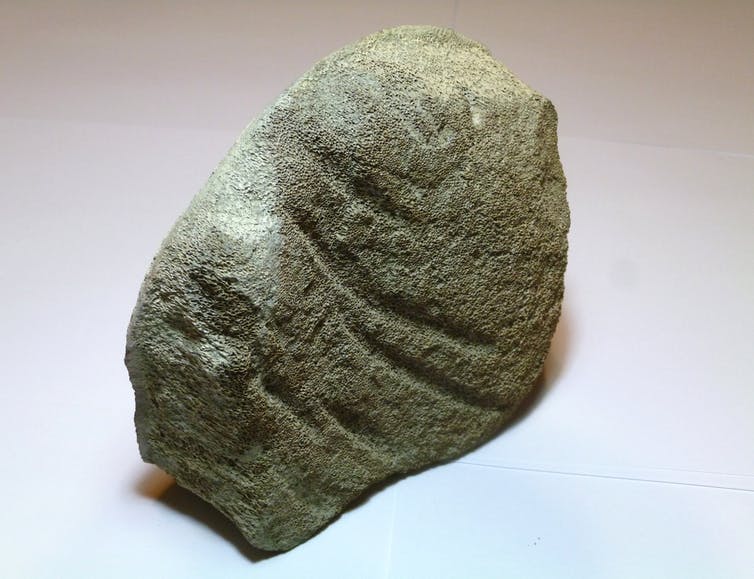Millions of years ago, giant sharks three times larger than today’s great whites stalked the world’s ocean. They’re long gone now, but occasionally, someone walking on a beach spots an odd triangular shape in the sand. On closer inspection, they realize it’s a fossilized tooth as large as a human hand, with sharp serrated edges. And they have to wonder: What was that beast eating?
These fossilized teeth hold clues to a mystery about a legend of the seas, a mammoth creature that was at the apex of the food chain – and then vanished.

A megalodon tooth found on the North Carolina coast.
Harry Maisch
It’s known as the megalodon, believed to be the largest shark species to ever exist. Evidence in the teeth and bite marks found on fossilized bones suggest these ancient sharks were swimming the ocean between 23 million and 3.5 million years ago. Scientists have estimated they reached lengths upwards of 50 feet (15 meters) – longer than a city bus.
The megalodon was the last species of a group of sharks called the megatooth sharks. We study the chemistry of fossils to better understand ancient animals, and while many mysteries remain about megalodon’s life and eventual extinction, its teeth are revealing some answers.
What did ancient sharks eat?
There are tantalizing clues about the diet of ancient sharks in the fossil record.
The shape and structure of their teeth can indicate general eating styles. Broad serrated megalodon teeth are thought to be particularly well adapted to gnawing on marine mammals, while the sharp and pointy teeth of other sharks lend themselves to piercing and tearing fish.
In some exceptional cases, fossil marine mammal bones have been found with the bite marks of a megalodon. Some sperm whale bones have evidence of megalodon attacks on their foreheads, a part of the whale that would have been rich in fats. Dolphin tailbones have also been found with deep megalodon tooth marks. Each of these incredible fossils offers a snapshot of one megalodon’s meal on one day millions of years ago.

This whale vertebra was bitten in half by a megalodon.
Jayson Kowinsky via Wikimedia, CC BY
Were marine mammals a part of megalodon’s regular diet, or just a special snack that day? And what else may have fallen prey to this massive shark?
Finding answers in the chemistry of fossil teeth
Using newly developed tools, we have been able to analyze the chemical composition of these fossil teeth, including samples from the United States, western Europe and Japan.
The results, published in two recent studies, tell us about the diet of each ancient shark and about the environment it lived in long before humans walked the Earth.
When animals eat, they acquire nutrients from their meals, including nitrogen and zinc. Because of this, nitrogen and zinc are passed up the food web from prey to predator.
Both nitrogen and zinc have…


